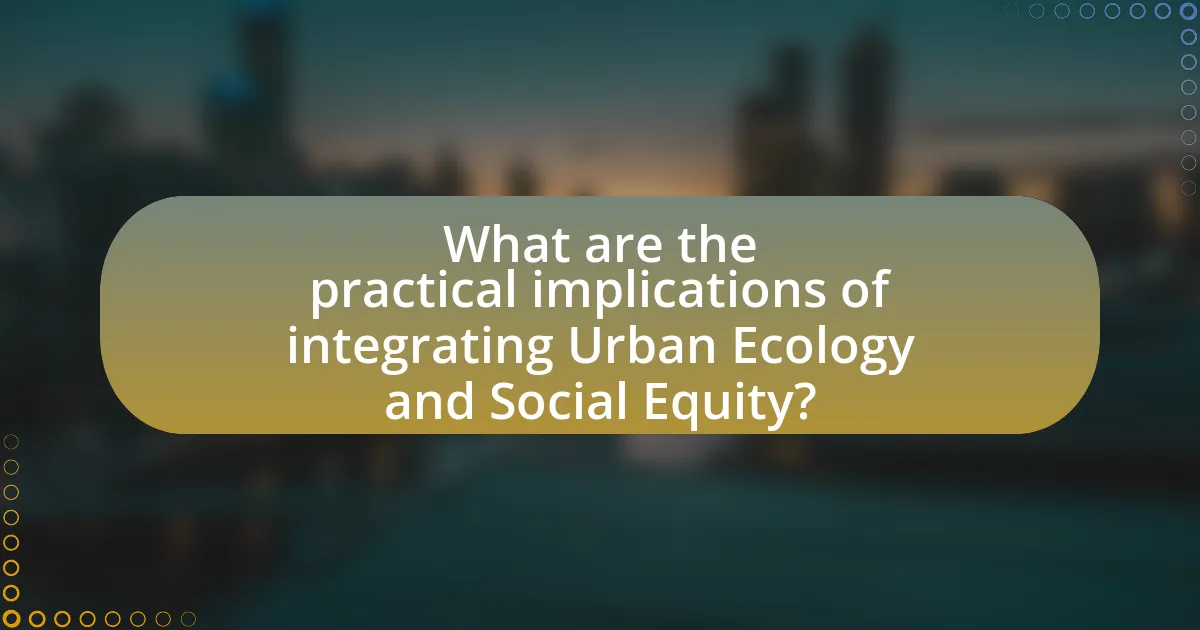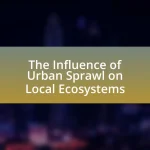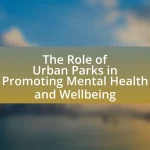The article explores the intersection of urban ecology and social equity, highlighting the relationship between environmental sustainability in urban areas and the equitable distribution of resources among diverse populations. It discusses how urban ecology focuses on the interactions between living organisms and their environments, while social equity emphasizes fair access to resources, particularly for marginalized communities facing environmental hazards. Key principles of urban ecology, such as biodiversity and green spaces, are examined alongside fundamental concepts of social equity, including fairness and justice. The article also addresses the challenges and barriers to achieving social equity in urban ecological practices, and it presents strategies for integrating these two fields to promote healthier, more inclusive urban environments.

What is the Intersection of Urban Ecology and Social Equity?
The intersection of urban ecology and social equity refers to the relationship between environmental sustainability in urban areas and the fair distribution of resources and opportunities among diverse populations. Urban ecology focuses on the interactions between living organisms and their urban environment, while social equity emphasizes the need for equal access to resources, services, and opportunities regardless of socioeconomic status. Research indicates that marginalized communities often face greater environmental hazards and have less access to green spaces, which can exacerbate health disparities. For instance, studies show that neighborhoods with higher poverty rates typically have fewer parks and more pollution, highlighting the need for integrated approaches that address both ecological health and social justice.
How do urban ecology and social equity relate to each other?
Urban ecology and social equity are interconnected as both address the distribution of resources and opportunities within urban environments. Urban ecology focuses on the relationships between living organisms and their urban environments, emphasizing the importance of green spaces, biodiversity, and sustainable practices. Social equity, on the other hand, seeks to ensure fair access to these resources and opportunities for all community members, particularly marginalized groups. Research indicates that equitable access to green spaces can improve health outcomes and quality of life, highlighting the necessity of integrating social equity into urban ecological planning. For instance, studies show that neighborhoods with more green spaces tend to have lower rates of heat-related illnesses, demonstrating how urban ecology can directly impact social equity by promoting healthier living conditions for all residents.
What are the key principles of urban ecology?
The key principles of urban ecology include the understanding of urban ecosystems as complex, dynamic systems that integrate social, economic, and environmental factors. Urban ecology emphasizes the importance of biodiversity, the role of green spaces, and the interactions between human activities and natural processes. Research indicates that urban areas can support diverse species and ecosystems, which are essential for ecological resilience and human well-being. For instance, studies show that urban green spaces can enhance biodiversity and provide ecosystem services, such as air purification and temperature regulation, thereby improving the quality of life for residents.
What are the fundamental concepts of social equity?
The fundamental concepts of social equity include fairness, justice, and access to resources and opportunities for all individuals, regardless of their background. Fairness emphasizes the need for equitable treatment and distribution of resources, while justice focuses on addressing systemic inequalities that disadvantage certain groups. Access to resources and opportunities ensures that all individuals can participate fully in society, which is essential for fostering inclusive communities. These concepts are supported by various studies, such as the 2018 report by the National Academy of Sciences, which highlights the importance of equitable access to urban green spaces for promoting health and well-being among marginalized populations.
Why is the intersection of urban ecology and social equity important?
The intersection of urban ecology and social equity is important because it addresses the need for sustainable urban environments that are accessible and beneficial to all communities. Urban ecology focuses on the relationships between living organisms and their urban environments, while social equity emphasizes fair access to resources and opportunities. Research indicates that cities with integrated urban ecological practices can improve public health, reduce environmental hazards, and enhance quality of life, particularly for marginalized communities. For example, studies show that green spaces in urban areas can lead to lower temperatures and improved air quality, which disproportionately benefits low-income neighborhoods that often lack such resources. Therefore, combining urban ecology with social equity initiatives ensures that environmental improvements are equitably distributed, fostering resilience and inclusivity in urban planning.
How does urban ecology impact social equity in cities?
Urban ecology significantly impacts social equity in cities by influencing access to green spaces, which are essential for community well-being and environmental health. Research indicates that neighborhoods with abundant green spaces tend to have better health outcomes, lower crime rates, and increased social cohesion. For instance, a study published in the journal “Environmental Health Perspectives” found that residents in greener neighborhoods reported better mental health and lower levels of stress. Additionally, urban ecology can exacerbate social inequities when marginalized communities lack access to these resources, leading to disparities in health and quality of life. Therefore, the design and management of urban ecosystems play a crucial role in either promoting or hindering social equity within urban environments.
What role does social equity play in urban ecological initiatives?
Social equity is essential in urban ecological initiatives as it ensures that all community members have equal access to environmental benefits and resources. By prioritizing social equity, urban ecological initiatives can address disparities in environmental quality, such as access to green spaces, clean air, and water, which disproportionately affect marginalized communities. Research indicates that equitable urban planning leads to improved health outcomes and community resilience, as seen in cities that have implemented inclusive policies promoting environmental justice. For instance, the Urban Institute’s report highlights that equitable access to parks and recreational areas significantly enhances community well-being and social cohesion.

What challenges exist at the intersection of Urban Ecology and Social Equity?
Challenges at the intersection of Urban Ecology and Social Equity include unequal access to green spaces, environmental hazards disproportionately affecting marginalized communities, and the lack of inclusive decision-making processes in urban planning. For instance, studies show that low-income neighborhoods often have fewer parks and recreational areas, leading to health disparities. Additionally, marginalized groups frequently face higher exposure to pollution and climate change impacts, which exacerbates social inequities. Furthermore, urban planning often overlooks the voices of these communities, resulting in policies that do not address their specific needs or concerns.
What are the barriers to achieving social equity in urban ecological practices?
Barriers to achieving social equity in urban ecological practices include systemic inequalities, lack of access to resources, and insufficient community engagement. Systemic inequalities, such as socioeconomic disparities, often result in marginalized communities having limited influence over ecological decision-making processes. Additionally, lack of access to resources, including funding and technical expertise, hinders these communities from implementing sustainable practices. Insufficient community engagement further exacerbates the issue, as urban ecological initiatives may not reflect the needs and priorities of all residents, particularly those from underrepresented groups. These barriers collectively impede the equitable distribution of environmental benefits and the active participation of all community members in urban ecological practices.
How do economic disparities affect urban ecological initiatives?
Economic disparities significantly hinder urban ecological initiatives by limiting access to resources and decision-making power for marginalized communities. These communities often lack the financial means to invest in sustainable practices, resulting in a reliance on cheaper, environmentally harmful options. For instance, a study by the Urban Institute found that neighborhoods with lower income levels are less likely to have green spaces, which are crucial for biodiversity and community well-being. Additionally, economic disparities can lead to unequal representation in urban planning processes, where wealthier populations influence policies that prioritize their interests over ecological sustainability. This inequity perpetuates environmental degradation in economically disadvantaged areas, further exacerbating social and ecological challenges.
What social factors contribute to inequities in urban environments?
Social factors that contribute to inequities in urban environments include socioeconomic status, racial and ethnic disparities, access to education, and housing instability. Socioeconomic status often dictates access to resources such as healthcare, employment opportunities, and safe living conditions, leading to significant disparities in quality of life. Racial and ethnic disparities manifest in systemic discrimination, affecting access to services and opportunities. Access to education is uneven, with lower-income neighborhoods frequently having underfunded schools, which perpetuates cycles of poverty. Housing instability, exacerbated by gentrification and inadequate affordable housing, forces marginalized communities into less desirable areas, further entrenching inequities. These factors collectively create a landscape where certain populations face significant barriers to achieving equitable outcomes in urban settings.
How can urban planning address these challenges?
Urban planning can address challenges at the intersection of urban ecology and social equity by integrating sustainable practices and equitable resource distribution into development strategies. For instance, planners can implement green infrastructure, such as parks and green roofs, which not only enhance biodiversity but also improve air quality and provide recreational spaces for underserved communities. Research indicates that access to green spaces is linked to improved mental health and social cohesion, particularly in low-income neighborhoods. Furthermore, urban planners can prioritize affordable housing near public transportation and essential services, ensuring that marginalized populations benefit from urban development. This approach aligns with the principles of environmental justice, which advocate for equal access to environmental benefits and the reduction of pollution exposure in vulnerable communities.
What strategies can promote both urban ecology and social equity?
Strategies that can promote both urban ecology and social equity include implementing green infrastructure, enhancing community engagement in urban planning, and ensuring equitable access to green spaces. Green infrastructure, such as parks and green roofs, improves urban biodiversity and air quality while providing recreational spaces for all community members. Research indicates that cities with more green spaces experience lower temperatures and improved mental health outcomes, benefiting marginalized populations disproportionately affected by urban heat islands.
Enhancing community engagement in urban planning allows residents to voice their needs and priorities, fostering a sense of ownership and responsibility towards local ecosystems. Studies show that participatory planning processes lead to more equitable distribution of resources and better environmental outcomes.
Ensuring equitable access to green spaces addresses disparities in urban environments, as neighborhoods with lower socioeconomic status often lack sufficient green areas. The National Recreation and Park Association reports that equitable access to parks can improve community health and social cohesion, thereby promoting both ecological sustainability and social equity.
How can community engagement enhance urban ecological efforts?
Community engagement enhances urban ecological efforts by fostering collaboration between residents and local organizations, leading to more effective environmental stewardship. Engaged communities are more likely to participate in initiatives such as tree planting, community gardens, and waste reduction programs, which directly contribute to urban biodiversity and sustainability. Research indicates that neighborhoods with active community involvement experience improved ecological outcomes, as seen in the 2018 study by the University of California, which found that community-led projects increased green space by 30% in urban areas. This active participation not only improves local ecosystems but also strengthens social ties, creating a sense of ownership and responsibility towards the environment.

What are the practical implications of integrating Urban Ecology and Social Equity?
Integrating Urban Ecology and Social Equity leads to enhanced community resilience and improved quality of life for marginalized populations. This integration promotes equitable access to green spaces, which has been shown to reduce urban heat islands and improve mental health outcomes. For instance, research indicates that neighborhoods with more green spaces experience lower rates of heat-related illnesses, benefiting vulnerable communities disproportionately affected by climate change. Additionally, equitable urban planning fosters community engagement and empowerment, ensuring that diverse voices are included in decision-making processes. This approach not only addresses environmental justice but also enhances social cohesion, as evidenced by studies demonstrating that inclusive urban environments lead to stronger community ties and reduced crime rates.
What successful case studies demonstrate this integration?
Successful case studies demonstrating the integration of urban ecology and social equity include the High Line in New York City and the Green Streets Initiative in Portland, Oregon. The High Line transformed an abandoned elevated railway into a public park, enhancing biodiversity and providing green space in a densely populated area, while also promoting social equity by increasing access to recreational areas for diverse communities. The Green Streets Initiative in Portland focuses on integrating green infrastructure into urban planning, improving stormwater management, and enhancing community engagement, which has led to increased environmental awareness and social cohesion among residents. Both cases illustrate how urban ecological projects can foster social equity by improving access to green spaces and involving communities in the planning process.
How have cities implemented urban ecological practices that promote social equity?
Cities have implemented urban ecological practices that promote social equity by integrating green spaces, enhancing public transportation, and fostering community engagement in environmental decision-making. For instance, cities like New York and San Francisco have developed urban greening initiatives that prioritize underserved neighborhoods, ensuring access to parks and recreational areas. Research from the American Planning Association indicates that equitable access to green spaces can improve mental health and community cohesion, particularly in marginalized communities. Additionally, cities have invested in sustainable public transit systems, reducing transportation barriers for low-income residents, which aligns with findings from the Institute for Transportation and Development Policy that highlight the correlation between accessible transit and social equity. These practices demonstrate a commitment to creating inclusive urban environments that address both ecological sustainability and social justice.
What lessons can be learned from these case studies?
The lessons learned from these case studies highlight the importance of integrating urban ecology with social equity to create sustainable communities. Specifically, these case studies demonstrate that equitable access to green spaces significantly improves community health and well-being, as evidenced by research showing that neighborhoods with more parks have lower rates of obesity and mental health issues. Additionally, the case studies reveal that involving local communities in decision-making processes leads to more effective environmental policies, as seen in initiatives where community input resulted in tailored solutions that addressed specific local needs. These findings underscore the necessity of collaboration between urban planners, ecologists, and community members to foster environments that are both ecologically sound and socially just.
What best practices can be adopted for future initiatives?
Best practices for future initiatives at the intersection of urban ecology and social equity include engaging diverse community stakeholders in the planning process, implementing green infrastructure that benefits all socioeconomic groups, and ensuring equitable access to green spaces. Engaging stakeholders fosters inclusivity and addresses specific community needs, as demonstrated by the success of participatory planning models in cities like Portland, Oregon, where community input led to more effective urban greening projects. Implementing green infrastructure, such as rain gardens and green roofs, not only mitigates urban heat but also provides job opportunities in underserved communities, as evidenced by programs in Chicago that have shown a 30% increase in local employment through green job training initiatives. Lastly, ensuring equitable access to green spaces is crucial; studies indicate that neighborhoods with more accessible parks experience improved mental health outcomes and community cohesion, highlighting the importance of prioritizing these areas in urban planning.
How can policymakers ensure equitable access to green spaces?
Policymakers can ensure equitable access to green spaces by implementing inclusive planning processes that prioritize underserved communities. This involves conducting assessments to identify areas lacking green spaces and engaging local residents in the decision-making process to reflect their needs. For instance, cities like New York have adopted the “Parks Without Borders” initiative, which aims to enhance access to parks in marginalized neighborhoods, demonstrating that targeted investments can improve equity in urban green space distribution.
What role do local communities play in fostering urban ecological equity?
Local communities play a crucial role in fostering urban ecological equity by actively participating in decision-making processes that affect their environment. These communities advocate for equitable access to green spaces, promote sustainable practices, and engage in local governance to ensure that ecological benefits are distributed fairly among all residents. For instance, studies have shown that neighborhoods with strong community organizations are more likely to secure funding for parks and community gardens, which enhances both ecological health and social cohesion. Additionally, local knowledge and cultural practices contribute to biodiversity conservation and the sustainable management of urban resources, further reinforcing the importance of community involvement in achieving ecological equity.


